 Image search results - "nihon" Image search results - "nihon" |
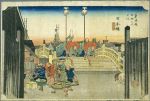
Hiroshige's woodblock print of Nihonbashi from his "Fifty-Three Stations of the Tokaido Road" series.
|
|

Eisen's woodblock print of Nihonbashi from his Kisokaido series.
|
|

Chuo-dori avenue looking toward Nihonbashi Bridge.
|
|

Nihonbashi Bridge ahead, with the expressway over it.
|
|

Omi Fair video taken on March 2, 2014 at Takashimaya Dept. Store in Nihonbashi, Tokyo. Funazushi, Omi beef, Biwa pearls, and more. We also saw Hiko-nyan.
|
|
|

Way to Takashimaya Dept. Store in Nihonbashi subway station.
|
|

The original Nihonbashi Bridge was built in 1603, out of wood.
|
|

Way to Takashimaya Dept. Store in Nihombashi subway station.
|
|

Nihonbashi Bridge and the ugly expressway above.
|
|
|

Nihonbashi Bridge today is the 19th reconstructed Nihonbashi Bridge since 1603. 日本橋
|
|

Takashimaya got its name from Takashima, Shiga Prefecture.
|
|
|

1st floor of Takashimaya Dept. Store.
|
|
|

Exhibit of Nagahama bonsai plum trees and folding screen from Hikone, 1st floor of Takashimaya Dept. Store during the Grand Omi Fair.
|
|
|
|

Bridge ornaments
|
|

Folding screen from Hikone (National Treasure).
|
|

Nihonbashi Bridge side view
|
|

PR exhibit for the Grand Omi Fair on the 8th floor.
|
|

Nihonbashi Bridge monument
|
|
|
|

The local neighborhood association wants this expressway to go underground.
|
|

1st floor of Takashimaya Dept. Store.
|
|

The double-arched bridge was built in 1911, made of granite.
|
|

Grand Omi Fair on 8th floor
|
|
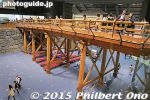
Replica of Nihonbashi Bridge at the Edo-Tokyo Museum in Ryogoku, Tokyo.
|
|
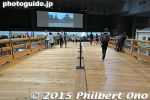
On the Nihonbashi Bridge replica at the Edo-Tokyo Museum in Ryogoku. It's not as arched as the one you see in ukiyoe prints.
|
|

About the replica of Nihonbashi Bridge at the Edo-Tokyo Museum in Ryogoku, Tokyo.
|
|

Sky roof
|
|

Tourist corner with samurai armor of Hikone's Ii Clan.
|
|

Expressway above the bridge.
|
|
|

One of the worse urban-planning decisions of the 1960s.
|
|

Funa-zushi 鮒寿し
|
|

Nihonbashi River
|
|
|

Looking toward Nihonbashi on Chuo-dori
|
|

Fish and shellfish from Lake Biwa
|
|

Bridge lamps
|
|

Ibuki Ham
|
|

Gargoyles on bridge
|
|

Ibuki Ham
|
|
|

Vegetable jam
|
|
|
|

Omi beef, each pack here cost over 2,000 yen. 近江牛
|
|
|
|
|
|

Stamp of Approval from Shiga
|
|
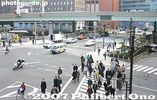
Nihonbashi as seen from Mitsukoshi Dept. Store.
|
|

Mochi making
|
|

Mochi
|
|

Memorial square for the Zero Milestone for the Five Major Roads
|
|

Adoberry sweets, from Adogawa, Takashima.
|
|
|

Adoberry sweets, from Adogawa, Takashima.
|
|

Japan's Zero Milestone for Roads 日本国道路元標
|
|
|

Japan's Zero Milestone 日本国道路元標
|
|

Entrance to crafts booths. 工芸展
|
|

Distances from the Zero Milestone to major cities such as Chiba, Mito, and Sapporo.
|
|

Omi crafts booths
|
|

Distances from the Zero Milestone to major cities such as Yokohama, Kyoto, and Kagoshima.
|
|

Kimono in the middle costs 1,995,000 yen. However the most expensive thing I saw was a Buddhist altar selling for 40 million yen (lots of gold leaf).
|
|
|

Making candles.
|
|

Kobuntei Villa was originally built in 1842 by Tokugawa Nariaki (1800-1860), the ninth Lord of Mito. It was his summer villa.
|
|

Kobuntei Villa, fusuma sliding door with painting of plum trees
|
|

Kobuntei Villa, fusuma sliding door with painting of azalea
|
|

Kobuntei Villa, fusuma sliding door with painting of fall leaves
|
|

Kobuntei Villa
|
|

Nihombashi subway station 日本橋駅
|
|

Nihombashi subway station where the Tozai and Ginza Line pass through. 日本橋駅
|
|

Kobuntei Villa
|
|

Way to Takashimaya Dept. Store
|
|

Kobuntei Villa, fusuma sliding door with painting of maple leaves
|
|

Chuo-dori boulevard in Nihonbashi 日本橋 中央通り
|
|

Kobuntei Villa
|
|

Eitai-dori 永代通り
|
|

Kobuntei Villa
|
|

Chuo-dori boulevard in Nihonbashi 日本橋 中央通り
|
|

Kobuntei Villa
|
|

Kobuntei Villa
|
|

Kobuntei Villa, fusuma sliding door with painting of cherry blossoms
|
|

Kobuntei Villa
|
|

Cherry Blossom Room, Kobuntei Villa
|
|

Takashimaya Dept. Store in Nihonbashi 高島屋 日本橋
|
|

Takashimaya Dept. Store 高島屋
|
|

Inside Takashimaya Dept. Store, Nihonbashi
|
|

Chuo-dori toward Mitsukoshi Dept. Store
|
|

Mitsukoshi Dept. Store annex
|
|

Mitsukoshi Dept. Store in Nihonbashi 三越デパート 日本橋
|
|
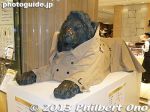
Lion statue wearing a coat inside Mitsukoshi Dept. Store in Nihonbashi in autumn.
|
|

Monument marking Tokyo's fish market during the Edo Period before it was destroyed by the 1923 earthquake and moved to Tsukiji in 1935.
|
|

Coredo complex which replaced the Tokyu Dept. Store.
|
|

Inside Coredo
|
|
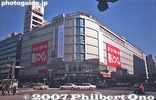
Tokyu Dept. Store in Nihonbashi on Jan. 31, 1999, its last day before the store closed. This store used to be Shirokiya.
|
|
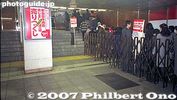
Crowd line up to enter Tokyu Dept. Store in Nihonbashi on Jan. 31, 1999.
|
|
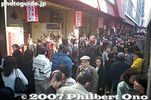
Crowd line up to enter Tokyu Dept. Store in Nihonbashi on Jan. 31, 1999.
|
|

Crowd enter Tokyu Dept. Store in Nihonbashi for the closeout sale on Jan. 31, 1999.
|
|
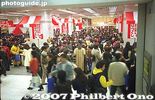
Crowd in Tokyu Dept. Store in Nihonbashi on Jan. 31, 1999.
|
|
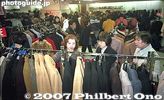
Crowd in Tokyu Dept. Store in Nihonbashi on Jan. 31, 1999. There were bargains to be had.
|
|
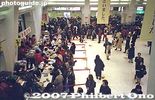
Crowd in Tokyu Dept. Store in Nihonbashi on Jan. 31, 1999.
|
|

Thank you banners in Tokyu Dept. Store in Nihonbashi on Jan. 31, 1999, last day.
|
|
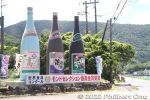
Local brewery producing brown sugar shochu in Tatsugo Town, Amami-Oshima. Uses brown sugar wholly produced in Amami-Oshima. Water comes from Jougo River (じょうご川) fed by an aquifer 120 meters underground. Factory tour and gift shop.They sell three shochu brands: Takakura (高倉), Hama-Chidori (浜千鳥乃詩 原酒), and Jougo (じょうご). https://www.jougo.co.jp/
|
|
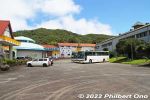
When you enter the premises, the factory is on the right, and gift shop on the left. Address: 鹿児島県大島郡龍郷町浦1864-2
|
|
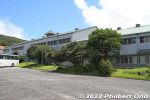
Amami Oshima Shuzo shochu factory.
|
|
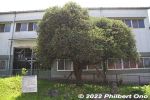
300-year-old tree named Sharinbai next to the shochu factory. Used for tsumugi fabric dyeing.
|
|
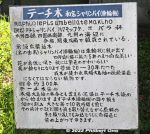
About the old Sharinbai tree.
|
|
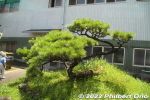
Pine tree next to the shochu factory.
|
|
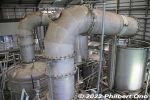
We had a guided tour of the shochu factory.
|
|
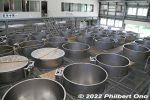
Vats
|
|
|
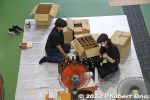
Packing process. Bottles of shochu being boxed.
|
|
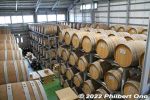
Casks for aging.
|
|
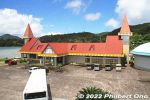
Amami Oshima Shuzo gift shop
|
|

Amami Oshima Shuzo gift shop shochu tasting.
|
|
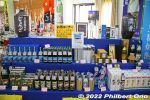
Amami Oshima Shuzo gift shop sells mainly shochu.
|
|
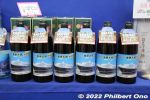
Amami Oshima Shuzo bottles of shochu with a cruise ship label (for visiting cruise ship passengers).
|
|
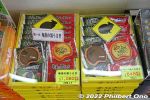
Confection in the shape of the Amami rabbit (Kuro-usagi). Amami-Oshima, Kagoshima
|
|
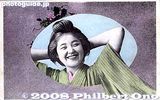
Out of all the geisha that have appeared on postcards, this ever-smiling geisha was unsurpassed in popularity. Her smiling visage appeared in 40 to 50 different poses in photographs and postcards made in Yokohama from the 1890s.
|
|

Her affable and infectious smile made her stand out during a time when most people posing for a photograph did not smile.
|
|
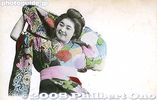
Her name has been a mystery, but I have come across hard evidence that she was a geisha named "Tokimatsu." But I will forever call her the "Laughing Geisha."
|
|
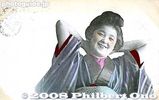
A saucy little Geisha. The pose is good.
|
|

Laughing Geisha with low neck. She's almost semi-nude. It is probably her sexiest pose of all. A great summertime card and one of my favorites. Hand-colored and postmarked Feb. 25, 1908 in Yokohama. The actual card is more yellowed.
|
|

Laughing Geisha with cowboy hat & cigar. This must be the most humorous pose she created. Those tourists must've gotten a big kick when they saw this card. A geisha from the wild, wild West. Even today, it elicits an affectionate laugh. One of my
|
|
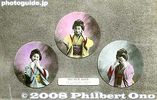
See, hear, nor speak no evil.
|
|
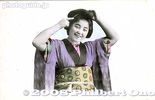
Combing her hair.
|
|
|

Laughing Geisha with fan. There are two Yokohama postmarks on this card. One in Japanese (over the stamp) and one in English. The actual card is more yellowed and almost brown, but I bleached it with Photoshop.There are two Yokohama postmarks on this card. One in Japanese (over the stamp) and one in English. Japanese postmarks have the date in the Year-month-day format. And English postmarks have it in the Day-month-Western year format. As you may know, Japan bases its years on the Emperor's reign. In the Japanese postmark, you can see "36" for the year. That's not 1936, but Meiji 36 that corresponds to 1903. Besides the Meiji Period (1868-1912), there's the Taisho Period (1912-1926) and the Showa Period (1926-1989). Since the Japanese postmark only indicates the last two digits of the year, it can be a pain to figure out which period the year belongs to. In most cases, we can figure it out with the stamp or type of postcard back.
|
|

Laughing Geisha on terrace. It looks like she's on the veranda of a restaurant along a river. If she's a Kyoto geisha, it would be the Kamo River. But these cards were made in Yokohama. I wonder if she was from Yokohama.
|
|

Laughing Geisha looking out. The card is postmarked 1903 from Yokohama. The actual card is more yellowed and almost brown, but I bleached it with Photoshop.
|
|

Laughing Geisha with baby. She's nicely posed, and you can even see the baby's face. But the color of her kimono is somewhat drab. A mother (or married woman) does not and need not wear a colorful kimono.
|
|

Laughing Geisha with umbrella. The sender probably wrote about his incredible adventures in Japan. Postmarked 1904 from Yokohama addressed to Hamburg, Germany. The actual card is more yellowed and almost brown, but I bleached it with Photoshop.
|
|

Laughing Geisha with umbrella. As you may have noticed, the umbrella (and fan) was a commonly used prop in tourist photos. Postmarked 1903 from Yokohama. The actual card is more yellowed and almost brown, but I bleached it with Photoshop.
|
|

Laughing Geisha in the rain. There's a horse in the background. Maybe she's watching a parade. The ground looks wet.
|
|

Laughing Geisha with Basket. It looks like she's dressed for picking tea leaves. This card, which has an undivided back, dates before 1907. The actual card is more yellowed.
|
|

Another shot of her picking tea leaves.
|
|
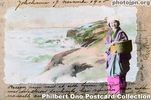
Laughing Geisha on Shore. It's kind of strange to see her at the beach but dressed to pick tea leaves. The message on this postcard was written in French, dated 1905.
|
|

Drawing water from a well.
|
|
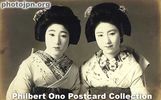
Pair of Geisha, autographed. One of my most treasured cards. This card was signed (on the chest area) by these two geisha with a fountain pen. Several other geisha also signed the back of the card. (See the next image.)
|
|
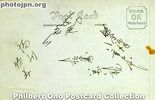
Pair of Geisha, autographed (back). This is the back of the preceding card. It looks like four geisha signed it.
|
|
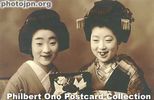
Geisha and maikoNot a good photo, but their names are written in hiragana on the back. They read "Suimatsu" on the left and "Shigezuru" on the right who is a maiko, not geisha. She has more ornaments in her hair than the geisha. Also notice their blackened teeth. If they are in Kyoto, a geisha is called "geiko." In Tokyo, a maiko (apprentice geisha) is called "hangyoku." This is a postcard-size photo and not a postcard.
|
|
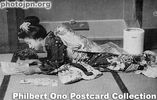
Maiko in Her RoomA private moment. This maiko is lying down in her kimono reading a comic book after getting tired of playing cards. Her mama-san probably would not be pleased to see her wrinkle the kimono like that. Not sure if this was staged or a candid shot. It's hard for anyone to lie down like that in a kimono.
|
|

Oiran courtesan. Also see my photos of an oiran show here. My oiran video at YouTube here.The highest-ranking geisha is called an oiran or tayu. She is escorted by two little attendant girls called kamuro. Notice her high clogs. It takes some skill to walk in those and she usually requires someone's shoulder to hold onto while walking. Sometimes at festivals or special events, you can see the Oiran Dochu procession where she walks in a parade together with geisha attendants.
|
|
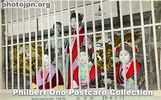
Shin-Yoshiwara prostitutes. They are sitting behind the "cage" which fronted the street for all to see (and choose) within the licensed quarters. Shin-Yoshiwara was a famous red-light district of Tokyo. Note that they are not geisha.Geisha were not prostitutes. This photo was taken during 1907-1911. The woman in the far back was the brothel's matron who supervised this live display and everything else. In 1912 when Emperor Meiji died, this live display of women was later replaced by framed photographs of each woman hung near the brothel's entrance. In 1958, prostitution was outlawed in Japan, and Yoshiwara was history.
|
|
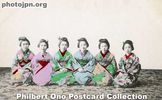
Brothel maids or prostitutes. Maids were employed to guide patrons to their rooms and serve sake and food. Or they could be low-class (cheap) prostitutes. Hand-colored, undivided back.
|
|

Geisha Pair Outside Geisha House. These two geisha know how to pose for the camera. It looks like Kyoto. You can tell that they are geisha because of the shorter kimono sleeve, subdued kimono design (mostly black), and their clogs (for rainy weather).
|
|

Patriotic Maiko. Card designed to encourage soldiers on the front line. Notice that her sleeves are so long that you can see her right sleeve touch the ground. That's the kimono of a maiko. This is a modern postcard reproduction.
|
|

Two Patriotic Maiko. To cheer up the soldiers on the front line, pretty and smiling maiko (apprentice geisha) often appeared on postcards for military mail. This card was postmarked Aug. 1940 from Shizuoka city. It was not addressed to a soldier though.Both women are maiko and not full-fledged geisha yet. The sleeves of a maiko's kimono reaches toward the ground as you can see here. (The sleeves of a geisha is shorter.) The kimono design is also more colorful and gaudy. Maiko also wear clogs called pokkuri. They are wedged at the front, so if you are not careful, you can trip forward. Geisha do not wear pokkuri.
|
|

Smiling Maiko Standing. Great smile. This is the same woman in the card where two maiko are holding the Japanese flag.
|
|

Smiling Maiko Sitting. Real-photo postcard to cheer up soldiers. This card was sent as military mail from Kyoto on New Year's Day 1939. The kanji characters on the fan says "Banzai," the traditional Japanese cheer for victory and happy occasReal-photo postcard to cheer up soldiers. This card was sent as military mail from Kyoto on New Year's Day 1939. The kanji characters on the fan says "Banzai," the traditional Japanese cheer for victory and happy occasions. It also means "long life," something that soldiers would like.
|
|

Laughing Maiko. Another card to cheer up the men at the front line.
|
|

Maiko hair ornaments. Maiko have more ornaments in their hair than geisha do. The hair ornaments differ depending on the current season. They usually have a flower motif, and if you look closely and see what flower it is, you can tell what season it is.
|
|

The maiko uses her real hair, not a wig. When her hair is down, it reaches her chest.
|
|

Smiling Maiko sitting in gardenNotice her left sleeve reaching the ground. A sign of a maiko's kimono, not a geisha's. Also, the high clogs that she wears are called pokkuri. Maiko wear them, but geisha do not.
|
|

Maiko on Gojobashi Bridge. Postcard-size real photo taken in Kyoto. She has been poorly posed. Her posture is bad, her kimono is ruffled, the sleeves look bad, and her feet are pointing in the wrong direction. Maiko usually know how to pose themselves.Postcard-size real photo taken in Kyoto. She has been poorly posed. Her posture is bad, her kimono is ruffled, the sleeves look bad, and her feet are pointing in the wrong direction. Maiko usually know how to pose themselves for a photograph. But not this one. Perhaps she's an amateur.
|
|

Maiko with umbrella. The quickest way to tell if she is a geisha or maiko is by looking at her back. The tell-tale sign of a maiko is her long obi sash hanging down behind. Whereas the geisha's sash has a short knot instead.
|
|

Girl with Umbrella. Hand-colored postcard dating before 1918. The kimono looks like casual wear, and the design pattern was typical during the turn of the 20th century. She's still in her teens it seems. One of the first vintage postcards I bought. Y2
|
|

Girl in Storm. Wires were used inside the kimono to make it look wind-blown like in a rainstorm. Even her clogs are for rain. Early photographers commonly imitated the poses and scenes depicted in ukiyoe woodcut prints and Nihonga paintings.Although the photographer and model were serious in making this picture, it makes you laugh.
|
|

Cheek-to-Cheek. One of my favorite postcards. I wonder if they were sisters. Real-photo postcard with no divided back. The actual card is more yellowed, but I bleached it with Photoshop.
|
|

Mona Lisa Smile. She's cute, ideal for a passport photo. But her hairstyle is more striking than anything. What do you call it? A Westernized Japanese hairstyle?
|
|

After a bath. That's what it looks like. She was another very photogenic woman.
|
|

Smiling for the camera. It's always nice to see a smiling woman on a vintage postard. This is not an ideal smile though. Kind of sheepish and unnatural. Sort of half-hearted and "halfway" like her fan which is only half open.
|
|
|

Swimsuit Beauties. These are typical swimsuits worn during the late 19th century. Horizontal stripes were in vogue. They are not posed very well, but there's something charming about them. This postcard is postmarked Aug. 1912. A nice summertime greet
|
|

Swimsuit pin-up. Another picture that makes you laugh. Apparently she felt sexy in that suit and knew how to pose like a pin-up swimsuit model.
|
|
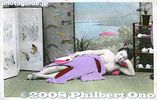
Nude woman lying down
|
|

Japanese Beauty. I would call this a representative example of a "Nihon Bijin" or Japanese Beauty photograph. She's posed formally, dressed in a kimono, and looking serene and attractive. She might bJe a geisha. Hand-colored, and undivided bI bought it for 1,200 yen.
|
|

Beauty with fan. The white space around her was for writing the correspondence. You could not write the message on the same side as the address. The back of the postcard was for the address only.So it has an undivided back, which means there is no dividing line between the address side and correspondence side, Postcards with an undivided back were made between 1900 and March 28, 1907. That's how we know the approximate age of this card even though it has no postmark.
|
|

Woman with pen and scroll. Judging from her hairstyle, this photo was probably taken during the Taisho Period (1912-1926).
|
|

Poor posture and how not to pose in a kimono.
|
|

Woman on bicycle. That's a thick shawl she's wearing. Must've been winter. It's unusual to see a bicycle used as a studio prop. Riding a bicycle while wearing a kimono must have been difficult. The postmark looks like 1908. Hand-colored.
|
|

In front of mirror. Hand-colored postcard sent as a Christmas card in 1914.
|
|

Calligraphy on a folding fan.
|
|

Dancing woman
|
|

Bride leaving her house vis rickshaw.
|
|

Bride arrives at the groom's house.
|
|
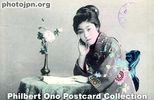
Flower in Vase. Nicely composed photograph. With a serene-looking face, she's an ideal postcard model. She also appears in the next postcard.
|
|

Girl at fence. Her posture is crooked, but somehow this photo looks nice. She's not sensationally attractive, but she's photogenic and comes across well. She also appears in the preceding postcard.
|
|

Woman with two flowers. She's holding the flowers in a cross or "X" mark. I wouldn't call that a good way to hold flowers (unless you're a hula dancer).
|
|

Woman and flower patch. Same woman as in the preceding postcard.
|
|

Girl with Bouquet. Would've been a great shot if she had smiled.
|
|

Woman with flowers. She's wearing two rings on her left hand. She looks like a wife alright. How can you tell? Well, her kimono has a plain design, and the word "married" is written on her face.
|
|

Woman and cherry blossoms. Unfortunately, she's too hunchbacked in this picture.
|
|

Teruha with chrysanthemum. The flower she's holding matches her kimono design that shows the same flower. Her name was Teruha and she appeared in many postcards. She was born in 1896 in Osaka and worked as a geisha in Shimbashi, Tokyo. Click to read mTeruha with chrysanthemum. The flower she's holding matches her kimono design that shows the same flower. Her name was Teruha and she appeared in many postcards. She was born in 1896 in Osaka and worked as a geisha in Shimbashi, Tokyo before becoming a Buddhist priest in Kyoto. Read more about her interesting life by James A. Gatlin at geikogallery.com.
|
|

Teruha sitting.Her name was Teruha and she appeared in many postcards. She's probably still in her teens in this photo. She was born in 1896 in Osaka and worked as a geisha in Shimbashi, Tokyo before becoming a Buddhist priest in Kyoto. Read more about her interesting life by James A. Gatlin at geikogallery.com.
|
|

Rear and side views. Nice side and back shot of a kimono woman. Can't see any wedding ring, but she looks married.
|
|

Tres Flores. Intriguing pose. It looks like a modern postcard, but it's postmarked 1907!
|
|

Typical woman and flower. Give a woman a flower and ask her to pose with it, and this is how she typically would hold it.
|
|

Flower arrangement. She's about to put the flower into the vase made of bamboo. On her lap, there's a pair of scissors used for flower arrangement. Her purple kimono has a design showing wisteria flowers. The season must have been spring.The card was printed in color so it's not that old.
|
|
|
|
|

Matsushima is a 30-40 min. train ride from Sendai on the JR Senseki Line.
|
|

Matsushima Kaigan Station on the JR Senseki Line. This is the closest to Matsushima's main attractions. Note that there is also a Matsushima Station. Don't get off there.
|
|

First time I saw a train station sign on the platform with a photo on it.
|
|

Welcome to Matsushima. Getting out of Matsushima Kaigan Station.
|
|

Matsushima Kaigan Station
|
|

Tourist info next to Matsushima Kaigan Station.
|
|

From Matsushima Kaigan Station, almost everything is within walking distance. If it were cherry blossom season, you could proceed first to Saigyo Modoshi-no-Matsu Park on a hilltop behind the station.
|
|
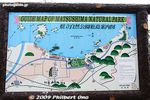
Map of Matsushima near Matsushima Kaigan Station. Places of interest include Ojima island, Matsushima boat cruise, Godaido island, Fukuura island, and Zuiganji temple.
|
|

I show you photos of the boat cruise first. There are many boats coming and going in Matsushima Bay. You have to decide which cruise to go on.
|
|

Matsushima Pier. There are boats which go around the Matsushima islands and return to Matsushima. Others go to Shiogama (toward Sendai) or a longer route toward Oku Matsushima.
|
|

Most boat cruises cost 1400 yen, taking about 50 min. Boats leave almost every 30 min. The boat cruise is the main and most popular activity at Matsushima.
|
|

Next to the boat pier is this building selling cruise tickets. No reservations required. You can buy a ticket even 5 min. before departure.
|
|

THe Nio Maru boat which I rode for the cruise. For an extra 600 yen, you can go on the first-class upper deck. I waited until it got sunny later in the day, then went on the cruise. The islands look better when it's sunny.
|
|

Nio Maru at Matsushima Port.
|
|

Inside Nio Maru's lower deck. Comfortable and air-conditioned. The places of interest are explained in Japanese and English during the cruise.
|
|

As each boat leaves, sea gulls follow.
|
|

The sea gulls follow where there's food, and the tourists are happy to toss junk food at them.
|
|

They even sell bird food on the boat.
|
|

These birds fly very close, within arm's reach.
|
|

Face to face with a bird. "Hey, any food for me??"
|
|

The boat passes by numerous pine-clad islands of Matsushima.
|
|

THis is one of the more famous Matsushima islands, named Kanejima with three holes. 鐘島
|
|

Kanejima
|
|
|

THe name "Matsushima" of course means "Pine Islands," so you may hear "Matsushima" in other places in Japan wherever there are pine-clad islands.
|
|
|

Another famous and unique island in Matsushima is Niojima, shaped like a Deva King found at the gate of Buddhist temples. 仁王島
|
|
|

Matsushima would also be interesting to geologists.
|
|

Famous for centuries, Matsushima has inspired many haiku poets like Matsuo Basho and painters.
|
|
|
|
|
|
|

This was my favorite island in Matsushima.
|
|

Back to Matsushima Port.
|
|

Matsushima Rest House is next to the pier, where you can buy cruise tickets or just rest on chairs. Tourist info counter also provided.
|
|

Route 45 running parallel to the shore. Busy road with shops and restaurants.
|
|

Near the boat pier is this a large park called Chuo Hiroba.
|
|

Chuo Hiroba, where tour groups meet.
|
|

Nearby is Godaido temple on a small island close to shore.
|
|

Godaido is another famous and storied icon of Matsushima. In any painting or depiction of Matsushima, Godaido is always there.
|
|

Godaido enshrines five statues representing the Mikkyo teachings of Shingon Buddhism.
|
|

Godaido 五大堂
|
|

Godaido 五大堂
|
|

Way to Godaido.
|
|
|
|

way to Godaido
|
|

The first bridge to Godaidojima island.
|
|

Second bridge to Godaido.
|
|

Godaido temple in Matsushima. This building was built in 1604 by Lord Date Masamune.
|
|

Godaido was first erected in 807 called Bishamondo. We cannot go inside. Important Cultural Property.
|
|
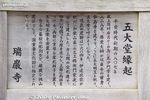
About Godaido
|
|

Godaido is also noted for wooden carvings of Eto zodiac animals. Cock.
|
|
| 861 files on 4 page(s) |
1 |
 |
|